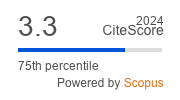Article | Open Access
Globalization of Security Threats: A Vicious Circle
| Views: | 2099 | | | Downloads: | 2648 |
Abstract: Statistical data and research suggest a strong correlation between various types of threats, radiating and enhancing each other: terrorism, violent conflicts, ecological threats, and political and economic instabilities. The most affected are the most vulnerable: countries of the Global South, and within those the underprivileged communities and peoples, including Indigenous populations. In this article, the interdependence of various types of threats will be presented based on data from the Global Terrorism Index, the Global Peace Index, the Ecological Threats Report, and the World Bank database. As of November 2023, according to World Bank estimates, over 1 billion people live in fragile and conflict‐affected situations. At the same time, violent conflicts are the primary drivers of terrorism (according to the Global Terrorism Index, in 2023, over 90% of attacks and 98% of terrorism deaths took place in countries in conflict). Moreover, data suggest that ecological threats and resource scarcity can contribute to the emergence and perpetuation of violent conflicts and terrorism. Among the case studies, the situation in the Sahel region will be analyzed with a particular focus on Burkina Faso—one of the least developed countries in the world that, as of 2024, is estimated as the country the most impacted by terrorism in the world. The author hypothesizes that the interdependence of security threats requires addressing those threats in a systemic way (with coordinated actions at local, national, and international levels) to effectively counter the negative impact on societies.
Keywords: Burkina Faso; least developed countries; peace; terrorism; the Sahel; war
Published:
© Katarzyna Maniszewska. This is an open access article distributed under the terms of the Creative Commons Attribution 4.0 license (http://creativecommons.org/licenses/by/4.0), which permits any use, distribution, and reproduction of the work without further permission provided the original author(s) and source are credited.


